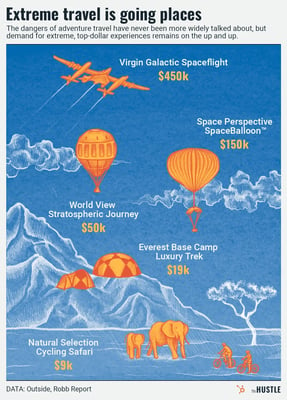Few stories this year — or century, really — captivated the world quite like the catastrophic loss of the Titan submersible.

Just eight words from the co-founder of OceanGate, the company behind the ill-fated journey, sum up why: “They were very well aware of the risks.”
The five passengers went anyway, paying $250k each for the chance to do so.
That’s extreme tourism for you
Despite its risks — and exorbitant price tags — adventure tourism is a fast-growing $282B+ industry, per Robb Report.
- Ninety percent of Adventure Travel Trade Association businesses reported revenue increases last year.
In June, expedition organizers held their collective breath — the Titan’s deadly ending brought a “reality check” as thrillseekers were reminded how real the industry’s dangers are.
The moment of truth didn’t last long: Experts told Robb Report the OceanGate disaster has done nothing to slow extreme tourism’s growth.
- In fact, the business is expected to grow 15.2% annually through 2030.
But why?
If you’re a reading-on-a-beach traveler like us, the allure of high-risk travel is baffling.
It’s all in brain chemistry and shows of status, per The Conversation:
- Risky behavior can elicit feelings of euphoria and a sense of personal transformation.
- Plus, the Insta-worthy adventures can double as status symbols.
As the boom continues, social bragging rights are getting harder to muster — after all, 100k+ people now visit Antarctica annually and multiple people have been to both space and the bottom of the Mariana Trench.
The boundary-pushing will only increase, with offerings becoming more daring (and more expensive). If tourists didn’t know the risks before, they do now. And they don’t much care, apparently.
Want in? Start planning now. World View, a startup taking travelers to the edge of space in pressurized capsules attached to weather balloons at $50k per seat, has already sold out its 2024 flights.











